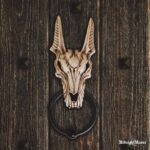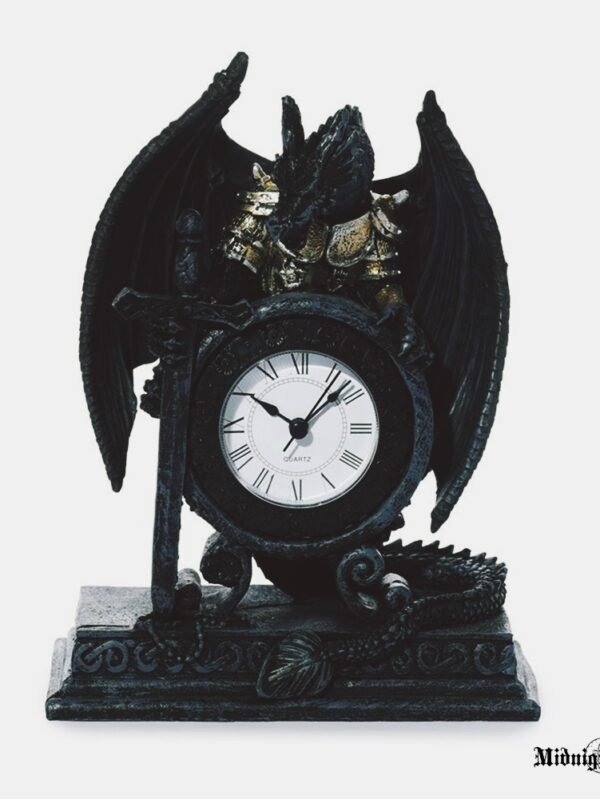Description
Durų Belstukas Sargas Anubis Egipto Mirusiųjų Dievas
Anubis (/əˈnjuːbɪs/;[2] Ancient Greek: Ἄνουβις), also known as Inpu, Inpw, Jnpw, or Anpu in Ancient Egyptian (Coptic: ⲁⲛⲟⲩⲡ, romanized: Anoup), is the god of funerary rites, protector of graves, and guide to the underworld, in ancient Egyptian religion, usually depicted as a canine or a man with a canine head.[3]
Like many ancient Egyptian deities, Anubis assumed different roles in various contexts. Depicted as a protector of graves as early as the First Dynasty (c. 3100 – c. 2890 BC), Anubis was also an embalmer. By the Middle Kingdom (c. 2055–1650 BC) he was replaced by Osiris in his role as lord of the underworld. One of his prominent roles was as a god who ushered souls into the afterlife. He attended the weighing scale during the “Weighing of the Heart”, in which it was determined whether a soul would be allowed to enter the realm of the dead. Anubis is one of the most frequently depicted and mentioned gods in the Egyptian pantheon; however, no relevant myth involved him.[4]
Anubis was depicted in black, a color that symbolized regeneration, life, the soil of the Nile River, and the discoloration of the corpse after embalming. Anubis is associated with his brother Wepwawet, another Egyptian god portrayed with a dog’s head or in canine form, but with grey or white fur. Historians assume that the two figures were eventually combined.[5] Anubis’ female counterpart is Anput. His daughter is the serpent goddess Kebechet.
In Egypt’s Early Dynastic period (c. 3100 – c. 2686 BC), Anubis was portrayed in full animal form, with a “jackal” head and body.[14] A jackal god, probably Anubis, is depicted in stone inscriptions from the reigns of Hor-Aha, Djer, and other pharaohs of the First Dynasty.[15] Since Predynastic Egypt, when the dead were buried in shallow graves, jackals had been strongly associated with cemeteries because they were scavengers which uncovered human bodies and ate their flesh.[16] In the spirit of “fighting like with like,” a jackal was chosen to protect the dead, because “a common problem (and cause of concern) must have been the digging up of bodies, shortly after burial, by jackals and other wild dogs which lived on the margins of the cultivation.”[17]

In the Old Kingdom, Anubis was the most important god of the dead. He was replaced in that role by Osiris during the Middle Kingdom (2000–1700 BC).[18] In the Roman era, which started in 30 BC, tomb paintings depict him holding the hand of deceased persons to guide them to Osiris.[19]
The parentage of Anubis varied between myths, times and sources. In early mythology, he was portrayed as a son of Ra.[20] In the Coffin Texts, which were written in the First Intermediate Period (c. 2181–2055 BC), Anubis is the son of either the cow goddess Hesat or the cat-headed Bastet.[21] Another tradition depicted him as the son of Ra and Nephthys.[20] The Greek Plutarch (c. 40–120 AD) reported a tradition that Anubis was the illegitimate son of Nephthys and Osiris, but that he was adopted by Osiris’s wife Isis:[22]
For when Isis found out that Osiris loved her sister and had relations with her in mistaking her sister for herself, and when she saw a proof of it in the form of a garland of clover that he had left to Nephthys – she was looking for a baby, because Nephthys abandoned it at once after it had been born for fear of Set; and when Isis found the baby helped by the dogs which with great difficulties lead her there, she raised him and he became her guard and ally by the name of Anubis.
George Hart sees this story as an “attempt to incorporate the independent deity Anubis into the Osirian pantheon.”[21] An Egyptian papyrus from the Roman period (30–380 AD) simply called Anubis the “son of Isis.”[21] In Nubia, Anubis was seen as the husband of his mother Nephthys.[1]
Hermanubis in the November panel of a Roman mosaic calendar from Sousse, Tunisia.
In the Ptolemaic period (350–30 BC), when Egypt became a Hellenistic kingdom ruled by Greek pharaohs, Anubis was merged with the Greek god Hermes, becoming Hermanubis.[23][24] The two gods were considered similar because they both guided souls to the afterlife.[25] The center of this cult was in uten-ha/Sa-ka/ Cynopolis, a place whose Greek name means “city of dogs.” In Book XI of The Golden Ass by Apuleius, there is evidence that the worship of this god was continued in Rome through at least the 2nd century. Indeed, Hermanubis also appears in the alchemical and hermetical literature of the Middle Ages and the Renaissance.
Although the Greeks and Romans typically scorned Egyptian animal-headed gods as bizarre and primitive (Anubis was mockingly called “Barker” by the Greeks), Anubis was sometimes associated with Sirius in the heavens and Cerberus and Hades in the underworld.[26] In his dialogues, Plato often has Socrates utter oaths “by the dog” (Greek: kai me ton kuna), “by the dog of Egypt”, and “by the dog, the god of the Egyptians”, both for emphasis and to appeal to Anubis as an arbiter of truth in the underworld.[27]















Atsiliepimai
There are no reviews yet